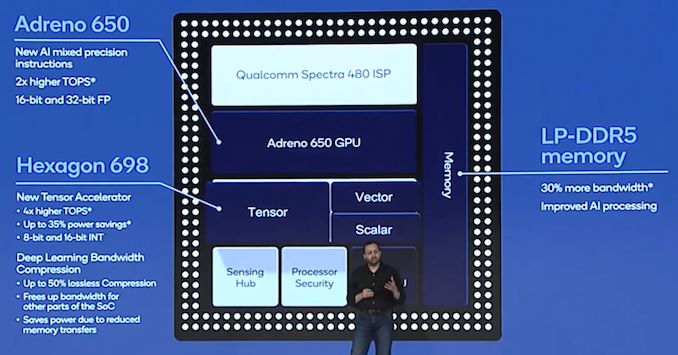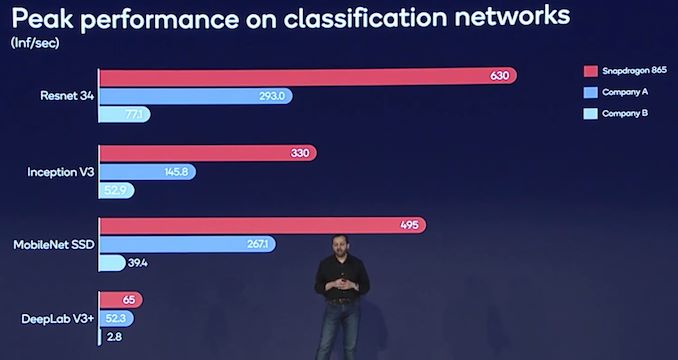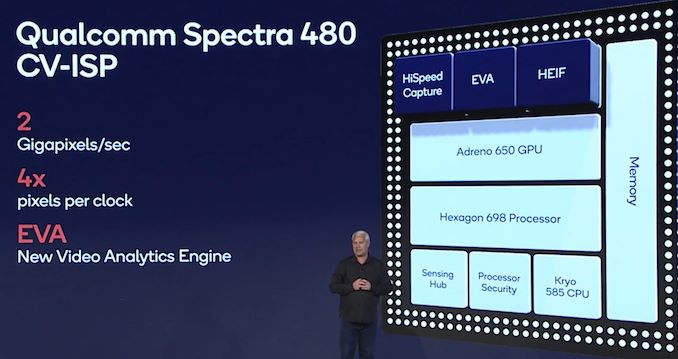Qualcomm Announces Snapdragon 865 and 765(G): 5G For All in 2020, All The Details
by Andrei Frumusanu on December 4, 2019 1:50 PM EST- Posted in
- Mobile
- Qualcomm
- Smartphones
- SoCs
- 7nm
- 5G
- Snapdragon 865
- Snapdragon 765
Immense AI, Camera and ISP Upgrades
New Hexagon 695 DSP: 4x Performance On New Tensor Cores - 15 TOPs Total on SoC
The Snapdragon 865 now ships with the new Hexagon 695 DSP block. The single biggest improvement of the new design is a massive quadrupling of the processing power of the dedicated tensor cores. This jump alone is able to double the SoC’s aggregate AI processing ability up from 7 TOPs to 15 TOPs.
Qualcomm here still doesn’t properly do a breakdown between the IP blocks which contribute to this number, but given that the GPU only saw a ~20% increase, and that the Hexagon’s scalar and vector execution units this year have remained the same in terms of performance, we estimate that the tensor units now roughly come in at around 10TOPs by themselves.
Qualcomm has also now included lossless weight and activation compression for the Tensor cores, being able to reduce bandwidth consumption up to 50%. This is a similar feature we've seen advertised by third-party NPU IP offerings, only that Qualcomm is going to be shipping this now in a product in just a few months.
Power efficiency of the block is also have said to have improved by 35%, making computations less costly in terms of battery life.
Qualcomm talks how about its inference performance and inference power efficiency is significantly higher than competing solutions. We don't know the comparison SoCs being showcased here, but a likely candidates here are the Apple A13 and the Kirin 990? It could also be an Exynos or other SoC.
New Spectra CV-480 ISP: 2 Gigapixels/s Enabling Massive Sensors
Aside from its 5G abilities, it’s very much evident that camera is very much at the very centre of the Snapdragon 865’s new features. The whole camera subsystem has seen some massive upgrades in the IP, and amongst the biggest improvements in capability lies in the new Spectra 480 computer-vision ISP.
The new IP has seen a major architectural change in that it’s now able to process 4 pixels per clock instead of just only 1 PPC as in the previous generation. This has now massively upgraded the pixel processing throughput to 2 Gigapixels/second, allowing the SoC a wide variety of use-cases that in the past simply weren’t possible due to lack of raw power.
Starting off with video capture, the new SoC is able to now record in 4K HDR while simultaneously capturing up to 64MP still shots at the same time. But 4K video isn’t the limit anymore – and you even can say that in terms of framerate as now 4K120 recording is supported, but the Snapdragon 865 now supports 8K30 video recording.
Video recording quality continues to support all the features we’ve seen in the previous generation, meaning 10-bit and various HDR standards such as HLG, HDR10, HDR10+, but now the new SoC expands this even further with the introduction of the ability to do live recording in the Dolby Vision HDR standard. Qualcomm explains that the Snapdragon 865 not only is the first smartphone SoC to be able to do this, but it’s the first camera platform of any kind in the world, as usual Dolby Vision content right now is enabled post-capture in the editing room, rather being something that’s being natively recorded by a camera.
The new improved capabilities of the ISP and video encoder also erase some current recording limitations, for example, slow-motion video recording at 960fps is sustained indefinitely instead of being limited to a couple of seconds of real-time footage.
Although normally I wouldn’t have brought this up, MediaTek’s recent release of the Dimensity 1000 did recently popularise the discussion topic: No, the Snapdragon 865 doesn’t support the AV1 codec for video decoding. It looks like we’ll have to wait for the next generation for that.
In terms of still capture photography, the new ISP performance will now allow for support for sensors of up to 200MP, which actually don’t yet exist as Samsung’s recent 108MP behemoth is currently the largest of its class right now.
The new ISP now has various new functionalities in order to improve noise reduction and contrast enhancements. Particularly the new noise reduction features is said to be quite difficult to achieve.
Although Qualcomm advertises the 200MP figure predominantly, it’s to be noted that actual capture with zero shutter lag (ZSL) is limited to 64MP – so there is a rather larger compromise in capturing at resolutions beyond 64MP.
High Refresh Rate Displays Normalised: Support For 144Hz
Already some vendors are leading the pack in 2019, but we’re expecting 2020 to see wide-range adoption of high refresh-rate displays. Even more importantly, we’ll be seeing implementations at high resolutions higher than 90 and 120Hz, supporting up to 144Hz displays. Qualcomm explains that the barrier that’s been lifted here is the SoC’s Display Processing Unit (DPU) that has had its throughput significantly increased.
I asked the company about the impact on battery life and which component of a phone accounts for the highest power increases. Surprisingly, it’s not any one component, with most of them seeing pretty much just an evenly distributed linear increase in power requirements, with the actual display panel itself (excluding the DDIC), seeing actually the least increases in power draw.















91 Comments
View All Comments
Kabm - Wednesday, December 4, 2019 - link
It is on Anand/Android Authority some time ago. Kirin chip need room to intergrate 5G, So they will use A77 in 5nm. Probably they has two 990 chips developed paralled, A76 and A77. The first win the race first to intergrated 5G flagship chip. The later will be know as Kirin 1020.The Snapdragon 865 or Apple chips has the room because they don't have any modem intergrated with them, but at more cost, more power consumption. Currently the Huawei V30 is the cheapest 5G phone in the world, and it still has flagship chip. Mediatek chip specs `remains a question, because they declared it long ago but no one see any phone with it.
tuxRoller - Thursday, December 5, 2019 - link
I had this article in mind (https://www.anandtech.com/show/14851/huawei-announ...I didn't notice anything said about die size being a limiting factor for this decision.
Here's the relevant section:
"A side note here: we had expected Huawei to launch the new Kirin with Arm’s latest A77 core, as it was announced earlier this year. Despite being a priority Arm partner member, the company’s technical team explained to us two things: firstly, the core decisions were made almost two years ago for this chip, but aside from that, they were not seeing the expected frequency from the A77 on TSMC’s 7nm processes.
Huawei stated that even though A77 hits higher peak performance, the power efficiency of the A77 and A76 on 7nm is practically identical, however due to better experience with A76 on 7nm, they were able to push the frequencies of the core much higher. It was cited that other companies with announced A77 products were only achieving 2.2 GHz on similar process technologies at other fabs. It was stated that A77 will likely come on a future product, most likely when 5nm becomes more widely available."
Make sense?
s.yu - Wednesday, December 4, 2019 - link
Doesn't ZSL just apply to stacked exposures?...On second thought Samsung probably already uses some sort of stacking in its auto HDR.Between the HMX lagging for a split second during capture, single exposure, and...sensor level binning? I'm hoping for the lag but suspect single exposure is more likely.
s.yu - Wednesday, December 4, 2019 - link
The bundled X55 is probably asking for a price bump on the price of the whole handset again, and for most people the 5G won't be touched for the lifetime of the device.To the surprise of nobody I guess?
Raqia - Wednesday, December 4, 2019 - link
If your data plan pricing goes down due to greater carrier efficiencies using 5G, it would be worth it. The biggest initial benefit might not be speed but cost per unit of data.s.yu - Wednesday, December 4, 2019 - link
Yeah regarding that...I believe it relies on net neutrality, not available in all markets, as I commented in a previous article:https://www.anandtech.com/show/15187/fireside-inte...
Actually are you sure about that? Say you're covered by a 20MHz wide band at 700MHz, you're saying running 5G on this band is cheaper per bit than running LTE on this same band? This seems to be the opposite to what I've heard, rather it's possibly cheaper on higher bands with immense scale, which only means urban centers to support saturating that usage.
peevee - Friday, December 6, 2019 - link
"If your data plan pricing goes down due to greater carrier efficiencies using 5G, it would be worth it."About as probable as somebody giving you $100 on the street.
And of course their costs are not going down given that they will now have to incur all the capital costs of 5G buildout. While almost nobody would still use it.
And mmWave is totally useless because of its physics.
Raqia - Tuesday, December 10, 2019 - link
If one carrier starts offering you lower prices for the same data and the others don't follow suit, the others lose business so they had better follow suit. (It's up to regulators to keep this competition going and not allow collusion preventing competition here.)Kabm - Wednesday, December 4, 2019 - link
On the otherhand, the 865 chip look very big and a gamer chip, so Samsung may not use them on all S11 version.Raqia - Wednesday, December 4, 2019 - link
Die size and transistor count info would be appreciated Andrei, particularly for the 865 and the x55. :)